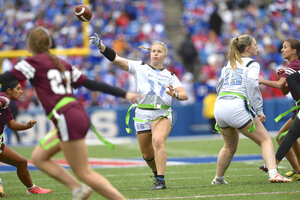The new kids in the huddle
Girls are flocking to a variation of American football – “flag,” as it is called – that elevates agility and teamwork. This more inclusive version does away with the physical contact of the traditional game.

High school girls play flag football at halftime of an NFL football game between the Buffalo Bills and the Arizona Cardinals in Orchard Park, N.Y., Sept. 8.
AP
It’s football season in America, and the girls are taking the field.
They’re playing flag football, that is, a version of the game played without pads or helmets, and with far less physical contact. It is now one of the fastest-growing sports for girls, sweeping into school athletics programs across the country. It may soon become a Division 1 college sport.
One stat tells it all: The number of girls ages 6 to 17 playing the game doubled during just the last school year, according to the National Federation of State High School Associations.
That growth represents a dramatic turn toward inclusivity in a game that traditionally left girls on the bleachers or on the cheerleading squad. And it brings another benefit: Roughly half of the girls who now play “flag,” as it is known, were not previously involved in school athletics.
While flag football doesn’t come with the same physical strength as the contact version, it does add to the range of sports for girls that can boost their confidence and demonstrate the sport ability to nurture character.
“The football field becomes a classroom for empowerment,” wrote Illiett Ojeda in a blog post for an organization called Miami Mom Collective. “Let’s pause for a moment and imagine our girls weaving through defenders, strategizing, and scoring those winning points. They’re ... breaking barriers, shattering stereotypes, and showcasing their capacity to excel in any arena.”
The game is spreading globally, too. More than 100 countries have organized leagues, according to the International Federation of American Football. Many of them are coed. In 2028, it will make its debut in the Summer Olympics in Los Angeles.
In this version of football, players wear belts with a strip – or flag – on each hip. The one with the ball is “tackled” when an opposing player pulls off one of the ball carrier’s flags. The game has given fathers new ways to connect with their daughters, especially if they are a coach in the sport – as Drew Brees, a former New Orleans Saints quarterback, is for his daughter’s team.
At a time when female athletes like gymnast Simone Biles and professional basketball player Caitlin Clark are drawing historic crowds in women’s sports, flag football is teaching young players new lessons about equality. That’s because this style of play relies less on physical strength and more on mental agility, selfless teamwork, and communication.
“This is the only sport they can truly compete against the boys,” Dallas Sartz, a girls flag football coach in California, told Gold Country Media. Last year, his team of 10-year-old girls stepped “out of their comfort zone” and beat a squad of boys. The result, he said, was a new sense of camaraderie among the players on both teams.
Sports in general are a “joyful means of awakening,” wrote author Therese Miller in a 2008 Sports Journal article. It also enlightens the “imagination to robust possibilities and convincing realities.” Across a growing number of athletic fields, an artful version of a rough-and-tumble game is widening views for girls as well as for boys.

